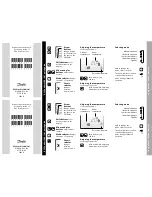
6
#L010120
November 2001
RS485 Protocol
The RS485 protocol is as follows, on board receivers will remain in active mode indefinitely. Transmitters
must be turned off when the unit is not sending data to prevent the line from sending and receiving data
at the same time. Therefore when the PC is transmitting data its driver will be turned on and each of
the units connected will have their drivers off. If they are requested to send data back to the PC, the
selected unit will turn it’s driver on to send the data then turn it off after it has completed transmission.
Note: The above protocol is done internally between the converter and the PCL501. The RS485 method
of communication allows increased noise immunity and increased communication distance of up to 4000
feet without repeaters. RS485 repeaters allow an additional 4000 feet per repeater.
Four Wire Configuration
Devices configured for four wire communications use TX and RX connections for both the transmit and the
receive pairs. The user can connect the transmit lines to the receive lines to create a two wire configuration
flexibility. Note that the signal ground line should also be connected in the system. This connection is
necessary to keep the VCM common mode voltage at the receiver within a safe range. From the diagram
below, it can be seen that all wires are run directly from the converter to the PCL501. For example TX+
from the converter goes to TX+ on the PCL501 and so on.
Two Wire Configuration
The two wire configuration reduces cabling costs by requiring only three wires. A, B and ground. The
PCL501 is designed to allow either the two or four wire configuration. To use the 2 wire configuration
simply wire TX+ to RX+, and TX- to RX- on your converter box. Then run a wire from ground, a wire
from TX+/RX+ and a wire from TX-/RX-, to the first PCL501 in the network. Finally do the same on the
terminal block of the PCL501 as the converter box. The diagram below illustrates how this configuration
is connected. RS422 systems require a dedicated pair of wires for each signal, a transmit pair, a receive
pair, and an additional pair for each handshake/control signal used (if required). The tristate capabilities of
RS485 allow a single pair of wires to share transmit and receive signals for half duplex communications.
This “two wire” configuration (note that an additional ground conductor should be used) reduces cabling
cost. RS485 devices may be internally or externally configured for two wire systems. Internally configured
RS485 devices simply provide “A” and “B” connections (sometimes labeled “-” and “+”).
July 2018
L010121







































